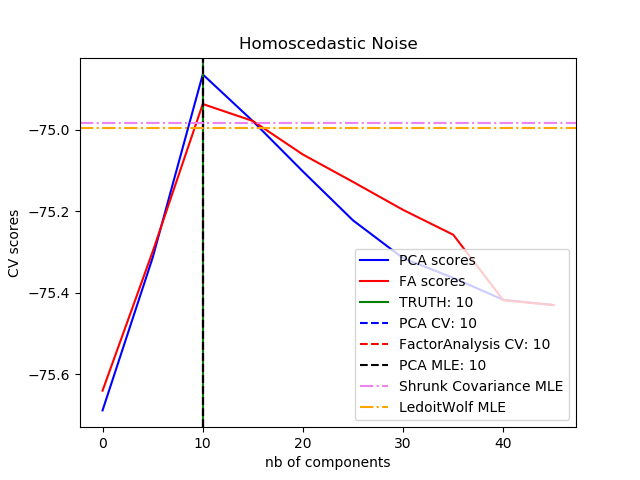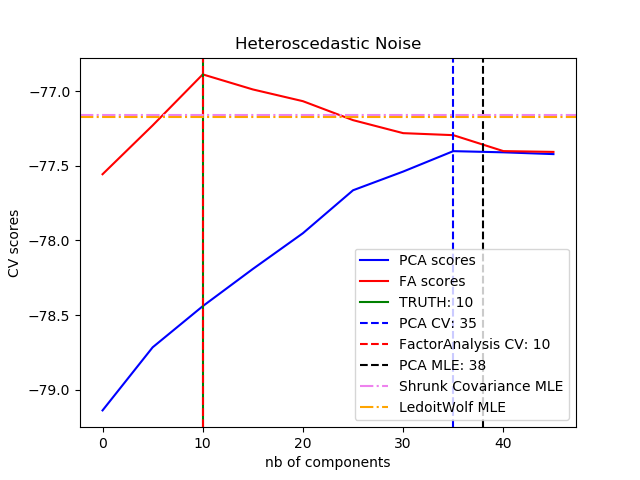基于概率主成分分析和因子分析(FA)的模型选择¶
概率PCA和因子分析是概率模型。其结果是,新数据的似然可用于模型选择和协方差估计。在这里,我们使用交叉验证在低秩的被破坏的同方差噪声数据上比较了PCA和FA(每个特征的噪声方差是相同的)或异方差噪声(每个特征的噪声方差是不同的)。在第二步,我们比较了模型从收缩协方差估计得到的似然。
可以观察到,在同方差噪声下,FA和PCA都成功地恢复了低秩子空间的大小。在这种情况下,PCA的似然高于FA。然而,当存在异方差噪声时,PCA失败并高估了秩。在适当的情况下,低秩模型比收缩模型更有可能出现。
PCA维数自动选择的自动估计。NIP 2000:598-604由ThomasP.Minka也做了比较。


best n_components by PCA CV = 10
best n_components by FactorAnalysis CV = 10
best n_components by PCA MLE = 10
best n_components by PCA CV = 35
best n_components by FactorAnalysis CV = 10
best n_components by PCA MLE = 38
# Authors: Alexandre Gramfort
# Denis A. Engemann
# License: BSD 3 clause
import numpy as np
import matplotlib.pyplot as plt
from scipy import linalg
from sklearn.decomposition import PCA, FactorAnalysis
from sklearn.covariance import ShrunkCovariance, LedoitWolf
from sklearn.model_selection import cross_val_score
from sklearn.model_selection import GridSearchCV
print(__doc__)
# #############################################################################
# Create the data
n_samples, n_features, rank = 1000, 50, 10
sigma = 1.
rng = np.random.RandomState(42)
U, _, _ = linalg.svd(rng.randn(n_features, n_features))
X = np.dot(rng.randn(n_samples, rank), U[:, :rank].T)
# Adding homoscedastic noise
X_homo = X + sigma * rng.randn(n_samples, n_features)
# Adding heteroscedastic noise
sigmas = sigma * rng.rand(n_features) + sigma / 2.
X_hetero = X + rng.randn(n_samples, n_features) * sigmas
# #############################################################################
# Fit the models
n_components = np.arange(0, n_features, 5) # options for n_components
def compute_scores(X):
pca = PCA(svd_solver='full')
fa = FactorAnalysis()
pca_scores, fa_scores = [], []
for n in n_components:
pca.n_components = n
fa.n_components = n
pca_scores.append(np.mean(cross_val_score(pca, X)))
fa_scores.append(np.mean(cross_val_score(fa, X)))
return pca_scores, fa_scores
def shrunk_cov_score(X):
shrinkages = np.logspace(-2, 0, 30)
cv = GridSearchCV(ShrunkCovariance(), {'shrinkage': shrinkages})
return np.mean(cross_val_score(cv.fit(X).best_estimator_, X))
def lw_score(X):
return np.mean(cross_val_score(LedoitWolf(), X))
for X, title in [(X_homo, 'Homoscedastic Noise'),
(X_hetero, 'Heteroscedastic Noise')]:
pca_scores, fa_scores = compute_scores(X)
n_components_pca = n_components[np.argmax(pca_scores)]
n_components_fa = n_components[np.argmax(fa_scores)]
pca = PCA(svd_solver='full', n_components='mle')
pca.fit(X)
n_components_pca_mle = pca.n_components_
print("best n_components by PCA CV = %d" % n_components_pca)
print("best n_components by FactorAnalysis CV = %d" % n_components_fa)
print("best n_components by PCA MLE = %d" % n_components_pca_mle)
plt.figure()
plt.plot(n_components, pca_scores, 'b', label='PCA scores')
plt.plot(n_components, fa_scores, 'r', label='FA scores')
plt.axvline(rank, color='g', label='TRUTH: %d' % rank, linestyle='-')
plt.axvline(n_components_pca, color='b',
label='PCA CV: %d' % n_components_pca, linestyle='--')
plt.axvline(n_components_fa, color='r',
label='FactorAnalysis CV: %d' % n_components_fa,
linestyle='--')
plt.axvline(n_components_pca_mle, color='k',
label='PCA MLE: %d' % n_components_pca_mle, linestyle='--')
# compare with other covariance estimators
plt.axhline(shrunk_cov_score(X), color='violet',
label='Shrunk Covariance MLE', linestyle='-.')
plt.axhline(lw_score(X), color='orange',
label='LedoitWolf MLE' % n_components_pca_mle, linestyle='-.')
plt.xlabel('nb of components')
plt.ylabel('CV scores')
plt.legend(loc='lower right')
plt.title(title)
plt.show()
脚本的总运行时间:(0分10.802秒)
Download Python source code:plot_pca_vs_fa_model_selection.py
Download Jupyter notebook:plot_pca_vs_fa_model_selection.ipynb




